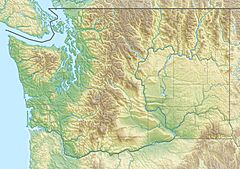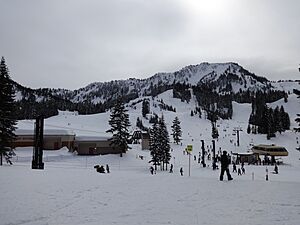Stevens Pass Ski Area facts for kids
Quick facts for kids Stevens Pass Ski Area |
|
|---|---|
 |
|
| Location | King County, near Skykomish, Washington, U.S. |
| Nearest city | Leavenworth 37 mi (60 km) east |
| Coordinates | 47°44′41″N 121°5′20″W / 47.74472°N 121.08889°W |
| Vertical | 1,800 ft (549 m) |
| Top elevation | 5,845 ft (1,782 m) Cowboy Mountain 5,600 ft (1,700 m) Big Chief Mountain |
| Base elevation | 4,061 ft (1,238 m) main base area 3,821 ft (1,165 m) Mill Valley |
| Skiable area | 1,125 acres (4.55 km2) |
| Runs | 37 |
| Lift system | 10 chairs |
| Lift capacity | 15,763 per hour |
| Terrain parks | 1 |
| Snowfall | 450 in (38 ft; 1,100 cm) |
| Snowmaking | yes |
| Night skiing | yes |
| Website | stevenspass.com |
The Stevens Pass Ski Area is a fun place to ski and snowboard in the northwest part of the United States. It is located at the top of Stevens Pass in the Cascade Range mountains of Washington. The lowest part of the ski area is 4,061 feet (1,238 m) above sea level. The highest point is 5,845 feet (1,782 m).
The "Mill Valley" area, also called the "backside," goes down to 3,821 feet (1,165 m). In total, there are 37 main ski runs covering 1,125 acres (4.55 km2) of land.
Contents
Skiing and Snowboarding Fun
Stevens Pass has many ski runs for all skill levels, from beginners to advanced skiers. Since there are no hotels right at the base, it's mostly a day trip spot. Many visitors come from the Seattle and Everett areas, traveling along U.S. Route 2. You can even enjoy Night skiing until 10 pm on most days during the middle of the season (except Mondays and Tuesdays).
The ski area is split into two main parts: the front side (facing north and east) and the back side (facing south).
Exploring the Front Side
From the main base area, you can directly reach several chairlifts:
- Kehr's (used to be called Big Chief) is a double chairlift. It takes you to a smooth, consistent run. There are also some small bumps and a steep, ungroomed slope for more experienced skiers.
- Daisy is a quad lift perfect for beginners. It gives you access to easy slopes right in the middle of the ski area. There's also a "magic carpet" (a conveyor belt lift) in the beginner area near Daisy.
- Hogsback is a fast quad lift. It leads to intermediate runs, some advanced tree runs, and the terrain parks.
- Skyline is another fast quad lift. It offers the longest intermediate and advanced runs on the front side of the mountain.
- Brooks is a fast quad lift that mostly takes you to beginner and intermediate slopes.
There are also three higher chairlifts on the front side:
- Seventh Heaven is a double chairlift for experts only. It reaches double-black diamond runs and areas for backcountry skiing near the top of Cowboy Mountain. You get to it from the Skyline lift.
- Tye Mill is a triple chairlift. It provides access to the backside of the mountain and to intermediate and advanced runs. You can reach it from the Hogsback lift or the Seventh Heaven chair.
- Double Diamond is a triple chairlift. It also gives access to the backside. Plus, it leads to expert-only, very steep, ungroomed runs like Double Diamond, Big Chief Bowl, and Wild Katz. You can get to it from Kehr's Chair.
Discovering the Back Side
The backside, known as Mill Valley, feels more natural with many runs that have scattered trees. The backside has two lifts that start from the same spot:
- Jupiter Express is a fast quad lift. It unloads near the top of Tye Mill.
- Southern Cross is a triple chairlift. It's the same physical lift as Double Diamond on the front side.
Cross-Country Skiing
The Stevens Pass Nordic Center offers 28 kilometers (about 17 miles) of groomed trails for cross-country skiing. These trails have different difficulty levels, so there's something for everyone.
History of Stevens Pass
The Stevens Pass ski resort first opened in the winter of 1937–38. It was started by two skiers, Don Adams and Bruce Kehr. The first lodge was built in 1937. It burned down in 1939 but was rebuilt the next year by the Civilian Conservation Corps (CCC). The CCC was a government program that provided jobs.
Over the years, the ski area has changed owners. In 2011, CNL Lifestyle bought Stevens Pass. Then, in 2016, Och-Ziff Capital Management purchased it. Finally, on August 15, 2018, Vail Resorts became the owner of Stevens Pass.
Avalanche Safety
The area around Stevens Pass can have avalanches. In 1910, the most deadly avalanche in U.S. history happened here. Two trains were stuck because of heavy snow. The avalanche swept them off the tracks, and 96 people lost their lives.
More recently, in 2012, another avalanche occurred. Three experienced skiers, Chris Rudolph, Johnny Brenan, and Jim Jack, died in an avalanche at Stevens Pass on February 19. This happened in an unmaintained backcountry area called Tunnel Creek. This area was marked as "ski at your own risk" after three feet (0.9 m) of fresh snow had fallen.
Future Plans for Stevens Pass
More and more people are moving to the Seattle area. This means more people are visiting the ski areas in Washington, including Stevens Pass. Sometimes, especially on winter weekends, Stevens Pass gets very crowded. In June 2007, a Master Plan was given to the Forest Service. This plan describes ideas for expanding and upgrading the resort over the next ten years.
Goals for Development
The main goals for future development include:
- Making the mountain experience better by adding different types of terrain. This includes wider trails, different slopes, and more gladed (tree skiing) areas.
- Increasing how many people can comfortably ski on the trails and lifts. This will help with crowds and use more of the skiable land that isn't fully used now.
- Making sure the ski terrain matches the skill levels of the people who visit.
- Adding more "in-bounds" (within the resort) and "hike-to" (requiring a short hike) adventure skiing spots.
- Providing many different gladed and off-piste (ungroomed) skiing options.
- Better managing how people use the backcountry areas that are accessed by lifts.
- Making guests happier by improving the lift and trail systems.
- Reducing crowding at the base area by adding facilities on the mountain.
- Developing new terrain and improving existing areas. This will consider climate change and how the area looks.
- Adding a small snowmaking system, mainly for the super-pipe and areas near the base.
- Designing new terrain to improve forest health and variety.
- Creating a summer mountain bike park that can be reached by lift. This will meet a growing demand for outdoor activities.
- Planning for and developing other mountain products and facilities as more people visit.
Front Side Improvements
There are plans for a new area called Northern Exposure to the left (east) of the current Big Chief lift. A new detachable quad lift would provide access to runs and glade skiing. This would add 115 acres (0.47 km2) of new terrain.
The Brooks lift was upgraded from a double to a fast quad, opening in the fall of 2019.
The Daisy lift was also upgraded from a triple to a fixed-grip quad, opening in the fall of 2019.
A Grace Lakes area is planned to the right of the top of Brooks. It would go downhill to the right (north) and have groomed trails and gladed runs. A fixed quad lift would serve this area, adding 80 acres (320,000 m2) of terrain. There would also be new adventure runs from the top of Skyline into the Grace Lakes area.
The Big Chief lift would be upgraded to a fixed quad. Its loading area would be moved slightly down the mountain for easier access.
A new fixed quad lift called "The Katz" would be added to the right of Big Chief, extending up and to the right.
Back Side Improvements
Improvements on the backside would happen on the right (east) side. To the immediate right of Southern Cross, new trails and glades would expand the area. A proposed expansion into Highlands Bowl, further to the right, would offer a backcountry experience for those willing to hike. A trail at the bottom would lead back to Southern Cross. This expansion would add 75 acres (300,000 m2) of terrain.
No lift changes are planned for the backside, except for the Jupiter Express, which was installed in 2013.
Base Area and Facilities
A new building called Solitude Lodge would be built near the top of Skyline.
Smaller yurts (round tents) would be built at the top of Tye Mill, at the top of the terrain park, and at the base of the lifts on the backside.
The main base lodges would be expanded and changed.
A new small lodge and ticket area would be built at the base of the Northern Exposure lift.
Also, 470 new parking spots would be added.




